SpringSecurity整合SpringBoot分布式版
分布式认证概念说明
分布式认证,即我们常说的单点登录,简称SSO,指的是在多应用系统的项目中,用户只需要登录一次,就可以访
问所有互相信任的应用系统。
分布式认证流程图
首先,我们要明确,在分布式项目中,每台服务器都有各自独立的session,而这些session之间是无法直接共享资
源的,所以,session通常不能被作为单点登录的技术方案。
最合理的单点登录方案流程如下图所示:
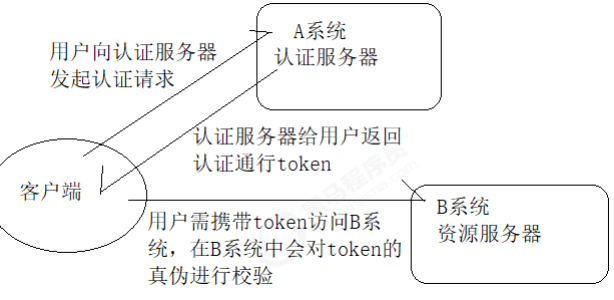
单点登录的实现分两大环节:
- 用户认证:这一环节主要是用户向认证服务器发起认证请求,认证服务器给用户返回一个成功的令牌token,
主要在认证服务器中完成,即图中的A系统,注意A系统只能有一个。 - 身份校验:这一环节是用户携带token去访问其他服务器时,在其他服务器中要对token的真伪进行检验,主
要在资源服务器中完成,即图中的B系统,这里B系统可以有很多个。
JWT介绍
概念说明
从分布式认证流程中,我们不难发现,这中间起最关键作用的就是token,token的安全与否,直接关系到系统的
健壮性,这里我们选择使用JWT来实现token的生成和校验。
JWT,全称JSON Web Token,官网地址https://jwt.io,是一款出色的分布式身份校验方案。可以生成token,也可
以解析检验token。
JWT生成的token由三部分组成:
- 头部:主要设置一些规范信息,签名部分的编码格式就在头部中声明。
- 载荷:token中存放有效信息的部分,比如用户名,用户角色,过期时间等,但是不要放密码,会泄露!
- 签名:将头部与载荷分别采用base64编码后,用“.”相连,再加入盐,最后使用头部声明的编码类型进行编
码,就得到了签名。
JWT生成token的安全性分析
从JWT生成的token组成上来看,要想避免token被伪造,主要就得看签名部分了,而签名部分又有三部分组成,其
中头部和载荷的base64编码,几乎是透明的,毫无安全性可言,那么最终守护token安全的重担就落在了加入的盐
上面了!
试想:如果生成token所用的盐与解析token时加入的盐是一样的。岂不是类似于中国人民银行把人民币防伪技术
公开了?大家可以用这个盐来解析token,就能用来伪造token。
这时,我们就需要对盐采用非对称加密的方式进行加密,以达到生成token与校验token方所用的盐不一致的安全
效果!
非对称加密RSA介绍
- 基本原理:同时生成两把密钥:私钥和公钥,私钥隐秘保存,公钥可以下发给信任客户端
- 私钥加密,持有私钥或公钥才可以解密
- 公钥加密,持有私钥才可解密
- 优点:安全,难以破解
- 缺点:算法比较耗时,为了安全,可以接受
- 历史:三位数学家Rivest、Shamir 和 Adleman 设计了一种算法,可以实现非对称加密。这种算法用他们三
个人的名字缩写:RSA。
JWT相关工具类
依赖
<dependency>
<groupId>io.jsonwebtoken</groupId>
<artifactId>jjwt-api</artifactId>
<version>0.10.7</version>
</dependency>
<dependency>
<groupId>io.jsonwebtoken</groupId>
<artifactId>jjwt-impl</artifactId>
<version>0.10.7</version>
<scope>runtime</scope>
</dependency>
<dependency>
<groupId>io.jsonwebtoken</groupId>
<artifactId>jjwt-jackson</artifactId>
<version>0.10.7</version>
<scope>runtime</scope>
</dependency>
载荷对象
/**
* @author 黑马程序员
* 为了方便后期获取token中的用户信息,将token中载荷部分单独封装成一个对象
*/
@Data
public class Payload<T> {
private String id;
private T userInfo;
private Date expiration;
}
JWT工具类
/**
* @author: 黑马程序员
* 生成token以及校验token相关方法
*/
public class JwtUtils {
private static final String JWT_PAYLOAD_USER_KEY = "user";
/**
* 私钥加密token
*
* @param userInfo 载荷中的数据
* @param privateKey 私钥
* @param expire 过期时间,单位分钟
* @return JWT
*/
public static String generateTokenExpireInMinutes(Object userInfo, PrivateKey privateKey, int expire) {
return Jwts.builder().claim(JWT_PAYLOAD_USER_KEY, JsonUtils.toString(userInfo)).setId(createJTI()).setExpiration(DateTime.now().plusMinutes(expire).toDate()).signWith(privateKey, SignatureAlgorithm.RS256).compact();
}
/**
* 私钥加密token
*
* @param userInfo 载荷中的数据
* @param privateKey 私钥
* @param expire 过期时间,单位秒
* @return JWT
*/
public static String generateTokenExpireInSeconds(Object userInfo, PrivateKey privateKey, int expire) {
return Jwts.builder().claim(JWT_PAYLOAD_USER_KEY, JsonUtils.toString(userInfo)).setId(createJTI()).setExpiration(DateTime.now().plusSeconds(expire).toDate()).signWith(privateKey, SignatureAlgorithm.RS256).compact();
}
/**
* 公钥解析token
*
* @param token 用户请求中的token
* @param publicKey 公钥
* @return Jws<Claims>
*/
private static Jws<Claims> parserToken(String token, PublicKey publicKey) {
return Jwts.parser().setSigningKey(publicKey).parseClaimsJws(token);
}
private static String createJTI() {
return new String(Base64.getEncoder().encode(UUID.randomUUID().toString().getBytes()));
}
/**
* 获取token中的用户信息
*
* @param token 用户请求中的令牌
* @param publicKey 公钥
* @return 用户信息
*/
public static <T> Payload<T> getInfoFromToken(String token, PublicKey publicKey, Class<T> userType) {
Jws<Claims> claimsJws = parserToken(token, publicKey);
Claims body = claimsJws.getBody();
Payload<T> claims = new Payload<>();
claims.setId(body.getId());
claims.setUserInfo(JsonUtils.toBean(body.get(JWT_PAYLOAD_USER_KEY).toString(), userType));
claims.setExpiration(body.getExpiration());
return claims;
}
/**
* 获取token中的载荷信息
*
* @param token 用户请求中的令牌
* @param publicKey 公钥
* @return 用户信息
*/
public static <T> Payload<T> getInfoFromToken(String token, PublicKey publicKey) {
Jws<Claims> claimsJws = parserToken(token, publicKey);
Claims body = claimsJws.getBody();
Payload<T> claims = new Payload<>();
claims.setId(body.getId());
claims.setExpiration(body.getExpiration());
return claims;
}
}
RSA工具类
/**
* @author 黑马程序员
*/
public class RsaUtils {
private static final int DEFAULT_KEY_SIZE = 2048;
/**
* 从文件中读取公钥
*
* @param filename 公钥保存路径,相对于classpath
* @return 公钥对象
* @throws Exception
*/
public static PublicKey getPublicKey(String filename) throws Exception {
byte[] bytes = readFile(filename);
return getPublicKey(bytes);
}
/**
* 从文件中读取密钥
*
* @param filename 私钥保存路径,相对于classpath
* @return 私钥对象
* @throws Exception
*/
public static PrivateKey getPrivateKey(String filename) throws Exception {
byte[] bytes = readFile(filename);
return getPrivateKey(bytes);
}
/**
* 获取公钥
*
* @param bytes 公钥的字节形式
* @return
* @throws Exception
*/
private static PublicKey getPublicKey(byte[] bytes) throws Exception {
bytes = Base64.getDecoder().decode(bytes);
X509EncodedKeySpec spec = new X509EncodedKeySpec(bytes);
KeyFactory factory = KeyFactory.getInstance("RSA");
return factory.generatePublic(spec);
}
/**
* 获取密钥
*
* @param bytes 私钥的字节形式
* @return
* @throws Exception
*/
private static PrivateKey getPrivateKey(byte[] bytes) throws NoSuchAlgorithmException, InvalidKeySpecException {
bytes = Base64.getDecoder().decode(bytes);
PKCS8EncodedKeySpec spec = new PKCS8EncodedKeySpec(bytes);
KeyFactory factory = KeyFactory.getInstance("RSA");
return factory.generatePrivate(spec);
}
/**
* 根据密文,生存rsa公钥和私钥,并写入指定文件
*
* @param publicKeyFilename 公钥文件路径
* @param privateKeyFilename 私钥文件路径
* @param secret 生成密钥的密文
*/
public static void generateKey(String publicKeyFilename, String privateKeyFilename, String secret, int keySize) throws Exception {
KeyPairGenerator keyPairGenerator = KeyPairGenerator.getInstance("RSA");
SecureRandom secureRandom = new SecureRandom(secret.getBytes());
keyPairGenerator.initialize(Math.max(keySize, DEFAULT_KEY_SIZE), secureRandom);
KeyPair keyPair = keyPairGenerator.genKeyPair();
// 获取公钥并写出
byte[] publicKeyBytes = keyPair.getPublic().getEncoded();
publicKeyBytes = Base64.getEncoder().encode(publicKeyBytes);
writeFile(publicKeyFilename, publicKeyBytes);
// 获取私钥并写出
byte[] privateKeyBytes = keyPair.getPrivate().getEncoded();
privateKeyBytes = Base64.getEncoder().encode(privateKeyBytes);
writeFile(privateKeyFilename, privateKeyBytes);
}
private static byte[] readFile(String fileName) throws Exception {
return Files.readAllBytes(new File(fileName).toPath());
}
private static void writeFile(String destPath, byte[] bytes) throws IOException {
File dest = new File(destPath);
if (!dest.exists()) {
dest.createNewFile();
}
Files.write(dest.toPath(), bytes);
}
}
SpringSecurity+JWT+RSA分布式认证思路分析
SpringSecurity主要是通过过滤器来实现功能的!我们要找到SpringSecurity实现认证和校验身份的过滤器!
回顾集中式认证流程
- 用户认证:
使用UsernamePasswordAuthenticationFilter过滤器中attemptAuthentication方法实现认证功能,该过滤
器父类中successfulAuthentication方法实现认证成功后的操作。 - 身份校验:
使用BasicAuthenticationFilter过滤器中doFilterInternal方法验证是否登录,以决定能否进入后续过滤器。
分析分布式认证流程
- 用户认证:
由于,分布式项目,多数是前后端分离的架构设计,我们要满足可以接受异步post的认证请求参数,需要修
改UsernamePasswordAuthenticationFilter过滤器中attemptAuthentication方法,让其能够接收请求体。
另外,默认successfulAuthentication方法在认证通过后,是把用户信息直接放入session就完事了,现在我
们需要修改这个方法,在认证通过后生成token并返回给用户。 - 身份校验:
原来BasicAuthenticationFilter过滤器中doFilterInternal方法校验用户是否登录,就是看session中是否有用
户信息,我们要修改为,验证用户携带的token是否合法,并解析出用户信息,交给SpringSecurity,以便于
后续的授权功能可以正常使用。
SpringSecurity+JWT+RSA分布式认证实现
创建父工程并导入jar包
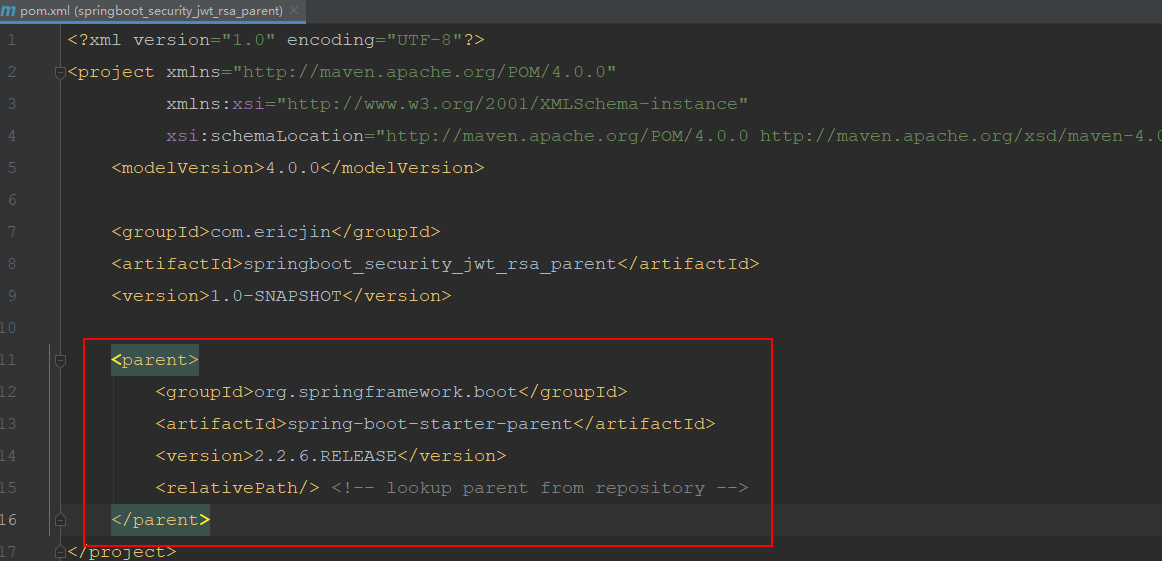
通用模块
创建通用子模块并导入JWT相关jar包
<dependencies>
<!--jwt所需jar包-->
<dependency>
<groupId>io.jsonwebtoken</groupId>
<artifactId>jjwt-api</artifactId>
<version>0.10.7</version>
</dependency>
<dependency>
<groupId>io.jsonwebtoken</groupId>
<artifactId>jjwt-impl</artifactId>
<version>0.10.7</version>
<scope>runtime</scope>
</dependency>
<dependency>
<groupId>io.jsonwebtoken</groupId>
<artifactId>jjwt-jackson</artifactId>
<version>0.10.7</version>
<scope>runtime</scope>
</dependency>
<!--lombok插件-->
<dependency>
<groupId>org.projectlombok</groupId>
<artifactId>lombok</artifactId>
</dependency> <!--处理日期工具包-->
<dependency>
<groupId>joda-time</groupId>
<artifactId>joda-time</artifactId>
</dependency> <!--处理json工具包-->
<dependency>
<groupId>com.fasterxml.jackson.core</groupId>
<artifactId>jackson-databind</artifactId>
<version>2.9.9</version>
</dependency> <!--日志包-->
<dependency>
<groupId>org.springframework.boot</groupId>
<artifactId>spring-boot-starter-logging</artifactId>
</dependency> <!--测试包-->
<dependency>
<groupId>org.springframework.boot</groupId>
<artifactId>spring-boot-starter-test</artifactId>
</dependency>
</dependencies>
导入工具类
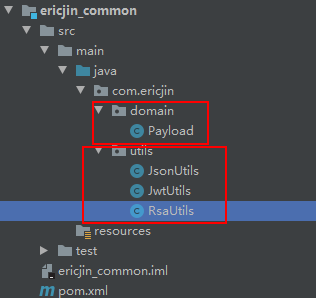
相应的类在上面已经给出
在通用子模块中编写测试类生成rsa公钥和私钥
import org.junit.jupiter.api.Test;
import static org.junit.jupiter.api.Assertions.*;
class RsaUtilsTest {
private String privateFilePath = "F:\\java\\code\\auth_key\\id_key_rsa";
private String publicFilePath = "F:\\java\\code\\auth_key\\id_key_rsa.pub";
@Test
void getPublicKey() throws Exception {
System.out.println(RsaUtils.getPublicKey(publicFilePath));
}
@Test
void getPrivateKey() throws Exception {
System.out.println(RsaUtils.getPrivateKey(privateFilePath));
}
@Test
void generateKey() throws Exception {
RsaUtils.generateKey(publicFilePath, privateFilePath, "ericjin", 2048);
}
}
认证服务
创建认证服务工程并导入依赖
<dependencies>
<dependency>
<groupId>org.springframework.boot</groupId>
<artifactId>spring-boot-starter-web</artifactId>
</dependency>
<dependency>
<groupId>org.springframework.boot</groupId>
<artifactId>spring-boot-starter-security</artifactId>
</dependency>
<dependency>
<groupId>com.ericjin</groupId>
<artifactId>ericjin_common</artifactId>
<version>1.0-SNAPSHOT</version>
</dependency>
<dependency>
<groupId>mysql</groupId>
<artifactId>mysql-connector-java</artifactId>
<version>5.1.47</version>
</dependency>
<dependency>
<groupId>org.mybatis.spring.boot</groupId>
<artifactId>mybatis-spring-boot-starter</artifactId>
<version>2.1.0</version>
</dependency>
</dependencies>
创建认证服务配置文件
server:
port: 9001
spring:
datasource:
driver-class-name: com.mysql.jdbc.Driver
url: jdbc:mysql:///security_authority
username: root
password: root
mybatis:
type-aliases-package: com.ericjin.domain
configuration:
map-underscore-to-camel-case: true
logging:
level:
com.ericjin: debug
rsa:
key:
pubKeyPath: D:\\auth_key\\rsa_key.pub
priKeyPath: D:\\auth_key\\rsa_key
提供解析公钥和私钥的配置类
import com.ericjin.utils.RsaUtils;
import lombok.Data;
import org.springframework.boot.context.properties.ConfigurationProperties;
import org.springframework.context.annotation.Configuration;
import javax.annotation.PostConstruct;
import java.security.PrivateKey;
import java.security.PublicKey;
@Data
@ConfigurationProperties(prefix = "rsa.key")
public class RsaKeyProperties {
private String pubKeyPath;
private String priKeyPath;
private PublicKey publicKey;
private PrivateKey privateKey;
@PostConstruct
public void loadKey() throws Exception {
publicKey = RsaUtils.getPublicKey(pubKeyPath);
privateKey = RsaUtils.getPrivateKey(priKeyPath);
}
}
创建认证服务启动类
import com.ericjin.config.RsaKeyProperties;
import org.springframework.boot.SpringApplication;
import org.springframework.boot.autoconfigure.SpringBootApplication;
import org.springframework.boot.context.properties.EnableConfigurationProperties;
@SpringBootApplication
@MapperScan("com.ericjin.mapper")
@EnableConfigurationProperties(RsaKeyProperties.class) // 将RsaKeyProperties放入到IOC容器中
public class AuthServerApplication {
public static void main(String[] args) {
SpringApplication.run(AuthServerApplication.class, args);
}
}
将上面集中式案例中数据库认证相关代码复制到认证服务中
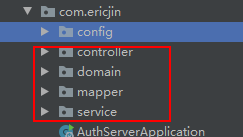
注意这里要去掉mapper中继承的通用mapper接口
处理器类上换成@RestController,这里前后端绝对分离,不能再跳转页面了,要返回数据。
编写认证过滤器
import com.ericjin.config.RsaKeyProperties;
import com.ericjin.domain.SysRole;
import com.ericjin.utils.JwtUtils;
import com.fasterxml.jackson.databind.ObjectMapper;
import org.springframework.security.authentication.AuthenticationManager;
import org.springframework.security.authentication.UsernamePasswordAuthenticationToken;
import org.springframework.security.core.Authentication;
import org.springframework.security.core.AuthenticationException;
import org.springframework.security.web.authentication.UsernamePasswordAuthenticationFilter;
import javax.servlet.FilterChain;
import javax.servlet.ServletException;
import javax.servlet.http.HttpServletRequest;
import javax.servlet.http.HttpServletResponse;
import com.ericjin.domain.SysUser;
import java.io.IOException;
import java.io.PrintWriter;
import java.util.HashMap;
import java.util.List;
import java.util.Map;
public class JwtLoginFilter extends UsernamePasswordAuthenticationFilter {
private AuthenticationManager authenticationManager;
private RsaKeyProperties prop;
public JwtLoginFilter(AuthenticationManager authenticationManager, RsaKeyProperties prop) {
this.authenticationManager = authenticationManager;
this.prop = prop;
}
/**
* 将前端传过来的用户信息提取出来并传递下去
* @param request
* @param response
* @return
* @throws AuthenticationException
*/
@Override
public Authentication attemptAuthentication(HttpServletRequest request, HttpServletResponse response) throws AuthenticationException {
try {
// 获取请求体中传来的数据
SysUser sysUser = new ObjectMapper().readValue(request.getInputStream(), SysUser.class);
UsernamePasswordAuthenticationToken token = new UsernamePasswordAuthenticationToken(sysUser.getUsername(),
sysUser.getPassword());
return authenticationManager.authenticate(token);
} catch (Exception e) {
try {
response.setContentType("application/json;charset=utf-8");
response.setStatus(HttpServletResponse.SC_UNAUTHORIZED);
PrintWriter writer = response.getWriter();
Map<String, Object> resultMap = new HashMap<>();
resultMap.put("code", HttpServletResponse.SC_UNAUTHORIZED);
resultMap.put("msg", "用户名或密码错误");
writer.write(new ObjectMapper().writeValueAsString(resultMap));
writer.flush();
writer.close();
} catch (IOException ioException) {
ioException.printStackTrace();
}
throw new RuntimeException(e);
}
}
/**
* 认证成功后回写token
* @param request
* @param response
* @param chain
* @param authResult
* @throws IOException
* @throws ServletException
*/
@Override
protected void successfulAuthentication(HttpServletRequest request, HttpServletResponse response, FilterChain chain, Authentication authResult) throws IOException, ServletException {
SysUser user = new SysUser();
user.setUsername(authResult.getName());
user.setRoles((List<SysRole>) authResult.getAuthorities());
// 生成token
String token = JwtUtils.generateTokenExpireInMinutes(user, prop.getPrivateKey(), 24 * 60);
// 将token写入请求头中
response.addHeader("Authorization", "Bearer " + token);
try {
response.setContentType("application/json;charset=utf-8");
response.setStatus(HttpServletResponse.SC_OK);
PrintWriter writer = response.getWriter();
Map<String, Object> resultMap = new HashMap<>();
resultMap.put("code", HttpServletResponse.SC_OK);
resultMap.put("msg", "认证通过");
writer.write(new ObjectMapper().writeValueAsString(resultMap));
writer.flush();
writer.close();
} catch (IOException ioException) {
ioException.printStackTrace();
}
}
}
编写检验token过滤器
import com.ericjin.config.RsaKeyProperties;
import com.ericjin.domain.Payload;
import com.ericjin.domain.SysUser;
import com.ericjin.utils.JwtUtils;
import com.fasterxml.jackson.databind.ObjectMapper;
import org.springframework.security.authentication.AuthenticationManager;
import org.springframework.security.authentication.UsernamePasswordAuthenticationToken;
import org.springframework.security.core.context.SecurityContextHolder;
import org.springframework.security.web.authentication.www.BasicAuthenticationFilter;
import javax.servlet.FilterChain;
import javax.servlet.ServletException;
import javax.servlet.http.HttpServletRequest;
import javax.servlet.http.HttpServletResponse;
import java.io.IOException;
import java.io.PrintWriter;
import java.util.HashMap;
import java.util.Map;
public class JwtVerifyFilter extends BasicAuthenticationFilter {
private RsaKeyProperties prop;
public JwtVerifyFilter(AuthenticationManager authenticationManager, RsaKeyProperties prop) {
super(authenticationManager);
this.prop = prop;
}
@Override
public void doFilterInternal(HttpServletRequest request, HttpServletResponse response, FilterChain chain) throws IOException, ServletException {
String header = request.getHeader("Authorization");
if (header != null && !header.startsWith("Bearer ")) {
// 如果携带了错误的token 给用户提示请登录
chain.doFilter(request, response);
response.setContentType("application/json;charset=utf-8");
response.setStatus(HttpServletResponse.SC_FORBIDDEN);
PrintWriter writer = response.getWriter();
Map<String, Object> resultMap = new HashMap<>();
resultMap.put("code", HttpServletResponse.SC_FORBIDDEN);
resultMap.put("msg", "请登录!");
writer.write(new ObjectMapper().writeValueAsString(resultMap));
writer.flush();
writer.close();
} else {
// 如果携带了正确格式的token
String token = header.replace("Bearer ", "");
// 验证token是否正确
// 先获取token中的载荷部分
Payload<SysUser> payload = JwtUtils.getInfoFromToken(token, prop.getPublicKey(), SysUser.class);
SysUser user = payload.getUserInfo();
if (user != null) {
UsernamePasswordAuthenticationToken authResult = new UsernamePasswordAuthenticationToken(user.getUsername(), null, user.getAuthorities());
// 将用户信息存入session,后面权限操作需要用到
SecurityContextHolder.getContext().setAuthentication(authResult);
chain.doFilter(request, response);
}
}
}
}
编写SpringSecurity配置类
import com.ericjin.filter.JwtLoginFilter;
import com.ericjin.filter.JwtVerifyFilter;
import com.ericjin.springboot_security_jsp.service.UserService;
import org.springframework.beans.factory.annotation.Autowired;
import org.springframework.context.annotation.Bean;
import org.springframework.context.annotation.Configuration;
import org.springframework.security.config.annotation.authentication.builders.AuthenticationManagerBuilder;
import org.springframework.security.config.annotation.method.configuration.EnableGlobalMethodSecurity;
import org.springframework.security.config.annotation.web.builders.HttpSecurity;
import org.springframework.security.config.annotation.web.configuration.EnableWebSecurity;
import org.springframework.security.config.annotation.web.configuration.WebSecurityConfigurerAdapter;
import org.springframework.security.config.http.SessionCreationPolicy;
import org.springframework.security.crypto.bcrypt.BCryptPasswordEncoder;
@Configuration
@EnableWebSecurity
@EnableGlobalMethodSecurity(securedEnabled = true)
public class SecurityConfig extends WebSecurityConfigurerAdapter {
@Autowired
private UserService userService;
@Autowired
private RsaKeyProperties prop;
/**
* 把加密对象放入IOC容器中
*
* @return
*/
@Bean
public BCryptPasswordEncoder passwordEncoder() {
return new BCryptPasswordEncoder();
}
// 认证用户的来源【内存或者数据库】
@Override
public void configure(AuthenticationManagerBuilder auth) throws Exception {
auth.userDetailsService(userService).passwordEncoder(passwordEncoder());
}
// 配置SpringSecurity相关信息
@Override
public void configure(HttpSecurity http) throws Exception {
// 释放静态资源 指定资源拦截规则 指定自定义认证页面 指定退出认证配置 csrf配置
http.csrf().disable() // 禁用csrf
.authorizeRequests()
.antMatchers("/product").hasAnyRole("USER", "ADMIN") // 表示访问所有的页面都要USER或者ADMIN角色
.anyRequest()
.authenticated() // 表明其他的资源只有通过认证后才能访问
.and() // 表示一个新的配置开始
.logout()
.logoutUrl("/logout")
.invalidateHttpSession(true) // 是否清空session
.permitAll()
.and()
.addFilter(new JwtLoginFilter(super.authenticationManager(), prop))
.addFilter(new JwtVerifyFilter(super.authenticationManager(), prop))
.sessionManagement().sessionCreationPolicy(SessionCreationPolicy.STATELESS); // 禁用session 不再使用
}
}
启动测试认证服务

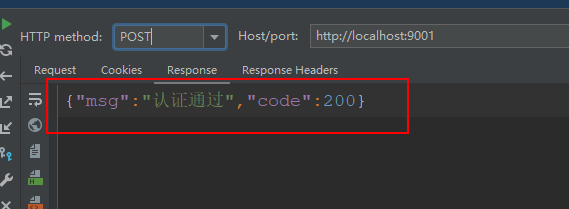
认证通过

token信息也已经存在,搭建成功!
资源服务
说明
资源服务可以有很多个,这里只拿产品服务为例,记住,资源服务中只能通过公钥验证认证。不能签发token!
创建产品服务并导入依赖
根据实际业务导包即可
<dependencies>
<dependency>
<groupId>org.springframework.boot</groupId>
<artifactId>spring-boot-starter-web</artifactId>
</dependency>
<dependency>
<groupId>org.springframework.boot</groupId>
<artifactId>spring-boot-starter-security</artifactId>
</dependency>
<dependency>
<groupId>com.ericjin</groupId>
<artifactId>ericjin_common</artifactId>
<version>1.0-SNAPSHOT</version>
</dependency>
<dependency>
<groupId>mysql</groupId>
<artifactId>mysql-connector-java</artifactId>
<version>5.1.47</version>
</dependency>
<dependency>
<groupId>org.mybatis.spring.boot</groupId>
<artifactId>mybatis-spring-boot-starter</artifactId>
<version>2.1.0</version>
</dependency>
<dependency>
<groupId>org.springframework.boot</groupId>
<artifactId>spring-boot</artifactId>
</dependency>
</dependencies>
编写产品服务配置文件
切记这里只能有公钥地址!
server:
port: 9002
spring:
datasource:
driver-class-name: com.mysql.jdbc.Driver
url: jdbc:mysql:///security_authority
username: root
password: root
mybatis:
type-aliases-package: com.ericjin.domain
configuration:
map-underscore-to-camel-case: true
logging:
level:
com.ericjin: debug
rsa:
key:
pubKeyPath: F:\\java\\code\\auth_key\\id_key_rsa.pub
编写读取公钥的配置类
import com.ericjin.utils.RsaUtils;
import lombok.Data;
import org.springframework.boot.context.properties.ConfigurationProperties;
import javax.annotation.PostConstruct;
import java.security.PublicKey;
@Data
@ConfigurationProperties(prefix = "rsa.key")
public class RsaKeyProperties {
private String pubKeyPath;
private PublicKey publicKey;
@PostConstruct
public void loadKey() throws Exception {
publicKey = RsaUtils.getPublicKey(pubKeyPath);
}
}
编写启动类
import com.ericjin.config.RsaKeyProperties;
import org.mybatis.spring.annotation.MapperScan;
import org.springframework.boot.SpringApplication;
import org.springframework.boot.autoconfigure.SpringBootApplication;
import org.springframework.boot.context.properties.EnableConfigurationProperties;
@SpringBootApplication
@MapperScan("com.ericjin.mapper")
@EnableConfigurationProperties(RsaKeyProperties.class) // 将RsaKeyProperties放入到IOC容器中
public class SourceProductApplication {
public static void main(String[] args) {
SpringApplication.run(SourceProductApplication.class, args);
}
}
复制认证服务中,用户对象,角色对象和校验认证的接口
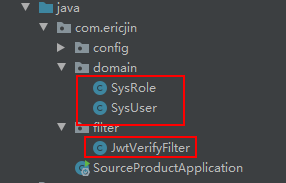
复制认证服务中SpringSecurity配置类做修改
去掉“增加自定义认证过滤器”即可!
import com.ericjin.filter.JwtVerifyFilter;
import org.springframework.beans.factory.annotation.Autowired;
import org.springframework.context.annotation.Configuration;
import org.springframework.security.config.annotation.method.configuration.EnableGlobalMethodSecurity;
import org.springframework.security.config.annotation.web.builders.HttpSecurity;
import org.springframework.security.config.annotation.web.configuration.EnableWebSecurity;
import org.springframework.security.config.annotation.web.configuration.WebSecurityConfigurerAdapter;
import org.springframework.security.config.http.SessionCreationPolicy;
@Configuration
@EnableWebSecurity
@EnableGlobalMethodSecurity(securedEnabled = true)
public class SecurityConfig extends WebSecurityConfigurerAdapter {
@Autowired
private RsaKeyProperties prop;
// 配置SpringSecurity相关信息
@Override
public void configure(HttpSecurity http) throws Exception {
// 释放静态资源 指定资源拦截规则 指定自定义认证页面 指定退出认证配置 csrf配置
http.csrf().disable() // 禁用csrf
.authorizeRequests()
.antMatchers("/product").hasAnyRole("USER", "ADMIN") // 表示访问所有的页面都要USER或者ADMIN角色
.anyRequest()
.authenticated() // 表明其他的资源只有通过认证后才能访问
.and()
.addFilter(new JwtVerifyFilter(super.authenticationManager(), prop))
.sessionManagement().sessionCreationPolicy(SessionCreationPolicy.STATELESS); // 禁用session 不再使用
}
}
编写产品处理器
import org.springframework.web.bind.annotation.RequestMapping;
import org.springframework.web.bind.annotation.RestController;
@RestController
@RequestMapping("/product")
public class ProductController {
// @Secured("ROLE_PRODUCT")
@RequestMapping("/findAll")
public String findAll() {
return "产品列表查询成功";
}
}
启动产品服务做测试
带上token,使用9002端口查询

查询成功,成功返回信息
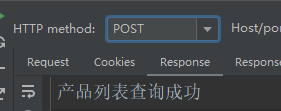
打开授权,需要ADMIN角色才能访问
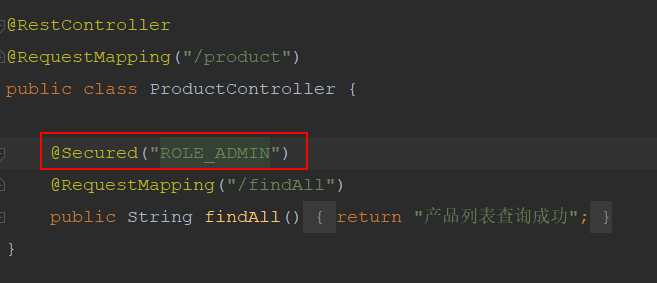
提示错误,表示权限控制起到了作用!








 浙公网安备 33010602011771号
浙公网安备 33010602011771号